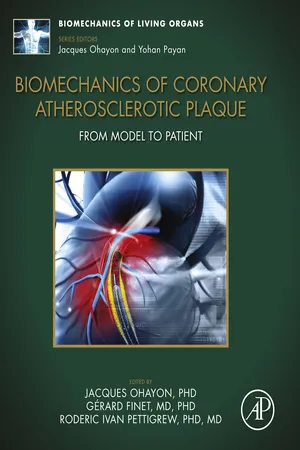
- 686 pages
- English
- ePUB (mobile friendly)
- Available on iOS & Android
About This Book
Biomechanics of Coronary Atherosclerotic Plaque: From Model to Patient, First Edition, is the first comprehensive text to focus on important biomechanical studies conducted in the last decade that have increased our understanding of coronary atherosclerotic plaque initiation, growth, and rupture, as well as improving the design of medical devices and clinical interventions, including surgical procedures. The book provides students, researchers, engineers, clinicians, and interventional cardiologists with an overview of the main topics related to the biomechanics of atherosclerosis, in a single volume written by several experts in the field.
This volume is part of the Biomechanics of Living Organs book series. The biomechanics of human soft tissues and organs has been an emerging research field since the publication of Y.C. Fung's original book series in the 1990s. The publication of such books entirely dedicated to a specific biomechanical subject is necessary to advance scientific research in the field of biomechanics and to transfer important knowledge to future generations. Therefore, this series of volumes on the biomechanics of living organs has been created. This series began in July 2017 with the publication of a first volume on the fundamentals of Hyperelastic Constitutive Laws for Finite Element Modeling of Living Organs. The current volume on the Biomechanics of Coronary Atherosclerotic Plaque, is the latest in this new series.
- Presents the main computational fluid dynamic studies performed, describing blood flow in healthy and pathological artery branches, including in coronary bifurcations
- Highlights the correlation between plaque initiation regions and blood shear stress amplitude
- Discusses the main biomechanical and mechanobiological models to highlight the importance of quantifying the residual and peak cap stresses and the presence of µ-calcifications to evaluate the risk of plaque rupture
- Introduces the most recent intravascular imaging biomarker techniques (elastography, palpography and modulography)
Frequently asked questions
Information
Table of contents
- Cover image
- Title page
- Table of Contents
- Biomechanics of Living Organs Series
- Copyright
- Contributors
- Note of the Series Editors
- Editor's Biography
- Foreword
- Preface
- Part 1. Biology, Physiopathology, Hemodynamics, Myogenic Responses and Clinical Intravascular Imaging of The Coronary Vascular Wall
- Part 2. Modeling Blood Flow in Arterial Branches and Bifurcations
- Part 3. Fluid-Structure Interaction, Stress Distribution and Plaque Rupture in Arterial Wall
- Part 4. Imaging Inflammatory Biomarkers For in Vivo Intravascular Plaque Characterization
- Part 5. Stenting, Coated Balloon Protocols and Modelling
- Index